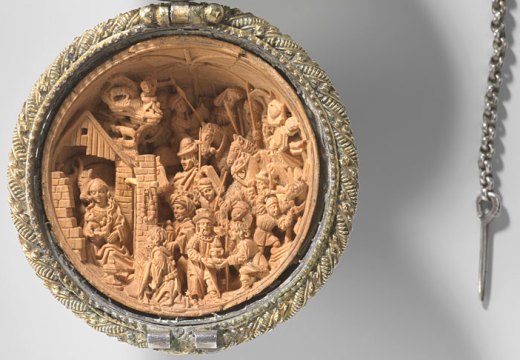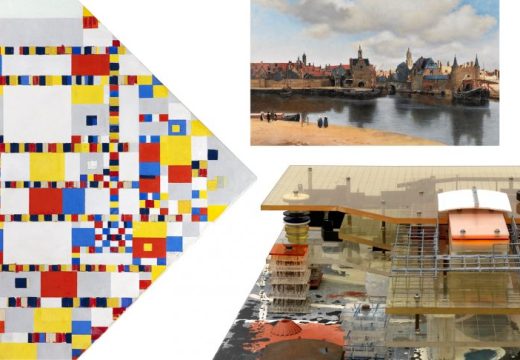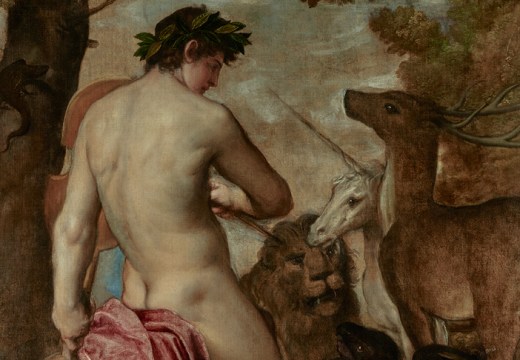To display his prized set of decorative ceramic urns, Meijer Lavino constructed a wooden cabinet inlaid with four convex feature windows. Each of the urns he displayed is moulded in the form of a lady, perching delicately in elegant dress on top of a base where a spout would have been for pouring coffee or jenever. The ladies’ hats – beribboned, feathered – lift off as lids for refilling; each draped, sculptural form is individually coloured, blue and white, bright yellow and blue and green, floral purple, pale red and yellow. Now the entire cabinet and its occupants have been transported and reinstalled along one wall of the Gemeentemuseum in The Hague, where they are on long-term loan and currently form the centrepiece of ‘The Lavino Collection’, the first public showing of one of the world’s most extraordinary troves of Dutch delftware.
Lavino, a Dutch steel magnate and passionate collector who died in 2005, purchased more than a thousand pieces dating from the second half of the 17th to the early 19th century over a 20-year period. His tastes were broad – the collection includes almost the full range of wares produced by Delft potters during that time – but his particular interest was in showcasing the decorative variety possible across versions of the same moulded figure or form: he liked to collect items in pairs or sets, each subtly different to the last.
Among the table decorations there are pairs of two different kinds of bright melon-shaped tureens, one set of cantaloupes scored with pale-green vertical lines and another covered in knobbly flecks, their bellies splitting in half to reveal the dish inside. Festive puzzle jugs come in a range of sizes, each perforated with differently arranged holes to frustrate inexperienced drinkers. Perhaps most remarkable is a set of 10 milk jugs shaped like monkeys clasping miniature jugs in their paws, their tails curling up behind them to produce handles. The monkey form, like many designs in Dutch delftware, imitated an earlier Chinese porcelain model: a jug made to look like a monkey holding a peach, the symbol of immortality. Dutch potters, uninterested in the symbolism or unaware of it, swapped the peach for a jug of milk, gave each monkey a jaunty Dutch hat and used the white space of the animal’s stomach for short gnomic descriptions of the jug’s purpose (‘the sweet monkey gives milk underneath his hat’, and so on).
The monkey jugs are part of an enormous array of animal forms in the Lavino Collection, displayed thronged together in their pairs like a ceramic Noah’s Ark. Stylish cow figurines are garlanded with painted flowers, both as a representation of contemporary butchers’ guild festivities and to show off skill with colour and line. Two leaping wild boars with wicked teeth exhibit the same fine brown fur pattern as a proud dog sitting on its haunches, evidence of Lavino’s interest in tracking down multiple examples of the same maker’s technique.
On a table in front of the windows and the lake outside, the fish and birds are arranged in their multiples. Most are designed for the dinner table as decorative lids to tureens: there are peacocks with grand spotted tails and surprised expressions; a rare set of green tureens shaped like coiled pikes clamping smaller fish in their jaws; dishes dotted blue and flecked with green reeds, topped with the flexible bodies of brown scaly plaice, their tails and heads flicking into the air. These are creatures that could in most cases be mass produced, but within the repeated forms and designs the character of each beast stands out, a little bit different to his fellows. The whole exhibition teems with life.
‘The Lavino Collection – Showcase of Dutch Delftware’ is at the Gemeentemuseum den Haag until 1 March 2020.
Unlimited access from just $16 every 3 months
Subscribe to get unlimited and exclusive access to the top art stories, interviews and exhibition reviews.



















![Masterpiece [Re]discovery 2022. Photo: Ben Fisher Photography, courtesy of Masterpiece London](http://www.apollo-magazine.com/wp-content/uploads/2022/07/MPL2022_4263.jpg)
It’s time for the government of London to return to its rightful home